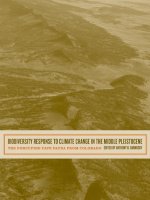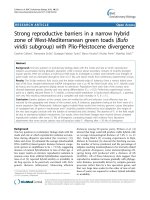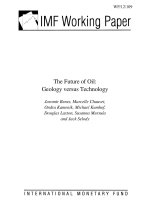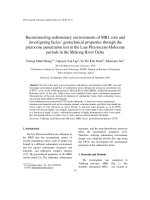Pleistocene geology
Bạn đang xem bản rút gọn của tài liệu. Xem và tải ngay bản đầy đủ của tài liệu tại đây (1.83 MB, 23 trang )
Late Cenozoic Geology
Neogene Period/Pleistocene Epoch
Defining the Pleistocene:
Lyell: 90-100% extant molluscs
Presence of glaciation (*Miocene)
1.6-10,000 y.b.p.
Evidence of Glaciation
The phenomenon had to be proven!
Louis Agassiz, James Hutton
QuickTime™ and a
TIFF (Uncompressed) decompressor
are needed to see this picture.
QuickTime™ and a
TIFF (Uncompressed) decompressor
are needed to see this picture.
Hutton’s native Scotland
Physical characteristics of glacial sediments
drift/till: texturally & mineralogically immature
Pleistocene till
fossil till =
tillite
QuickTime™ and a
TIFF (Uncompressed) decompressor
are needed to see this picture.
Permian,
Gondwana
QuickTime™ and a
TIFF (Uncompressed) decompressor
are needed to see this picture.
QuickTime™ and a
TIFF (Uncompressed) decompressor
are needed to see this picture.
Proterozoic
Gowganda
Fm., Canada
outwash: well-sorted, stratified, but associated
with till
QuickTime™ and a
TIFF (Uncompressed) decompressor
are needed to see this picture.
Glacial landforms:
U-shaped valleys, cirques, horns, aretes (alpine)
Moraines, drumlins,
eskers, outwash
plains, poor drainage
(continental)
Geologic Record of Glaciations
Cenozoic (0-20 mybp; Miocene-Pleistocene)
Late Paleozoic (230-350 mybp) Gondwana
Siluro-Devonian (S. America)
Ordovician (North Africa)
Ediacarian (700 mybp)-Snowball Earth??
Late Archean/Early Proterozoic (2.7-2.3 bybp)
Gowganda Fm., Canada
Causes of Glaciation
Explanations must account for:
relative rarity of this phenomenon
alternating glacial/interglacial episodes (cyclicity)
I. Astronomical hypotheses (Milankovitch)
Eccentricity
(shape of Earth’s orbit)
Tilt of Earth’s axis
Precession of Earth’s orbit
II. Atmospheric Hypotheses
Carbon dioxide greenhouse effect
“Impact winter” dust cloud from impact/volcanism
III. Oceanic circulation
IV. Plate tectonics
Ultimate control? Combination of astronomical
parameters and position of plates?
North American Glacial centers
Ohio River is
southern extent
Pleistocene history of the Great Lakes
Note: 4 glacial advances is probably an
oversimplification! There are 16 recorded
in Europe for the same time interval!
Glacial moraines
dominate Great
Lakes region
topography
Compare glacial
(surficial) map of
Michigan to
bedrock map:
Rise and Fall of the Great
Lakes (themes in the movie)
Glacial/interglacials
Effects of a mile-thick
glacier:
subsidence/rebound
changes to drainage
Great Lakes carved out
along pre-glacial
drainage
Glacial features:
Scoured bedrock
Erratics
Drumlins
Human impact (Lake Erie
then & now)
Other North American Glacial Phenomena: large fossil lakes
Pluvial, e.g., Lake Bonneville (ancient Salt Lake)
QuickTime™ and a
TIFF (Uncompressed) decompressor
are needed to see this picture.
QuickTime™ and a
TIFF (Uncompressed) decompressor
are needed to see this picture.
Proglacial, e.g., Lake Agassiz
“Scablands” flood from release of glacial Lake Missoula
The importance of moraines
QuickTime™ and a
TIFF (Uncompressed) decompressor
are needed to see this picture.
QuickTime™ and a
TIFF (Uncompressed) decompressor
are needed to see this picture.
pubs.usgs.gov/gip/ capecod/glacial.html
Biological Effects of ice ages….









